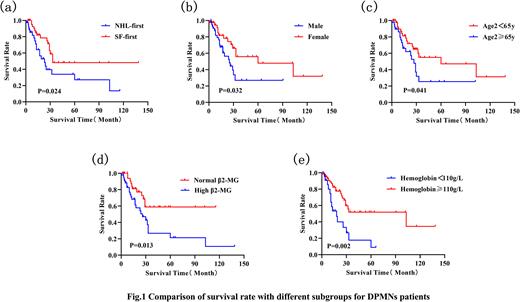Abstract
Non-Hodgkin lymphoma (NHL) combined with malignant solid tumors are a unique subtype of double primary malignant neoplasms (DPMNs). With the advancements in diagnostic procedures and the continuous development of new drugs, the overall survival (OS) of patients with malignant tumors has been prolonged,allowing more patients with malignant tumors to survive long enough to develop a second tumor. Most studies on this combination of DPMNs have been case reports and epidemiological investigations, and studies with a large sample size for summarizing the clinical characteristics have been lacking.
To investigate the clinical features, survival, and prognostic factors of patients with DPMNs comprising NHL and malignant solid tumors. The clinical data of patients with NHL diagnosed at the First Hospital of Jilin University from July 2011 to July 2021 were reviewed. Of 2337 patients diagnosed as having NHL, 90 (3.85%) patients were diagnosed as DPMNs according to the diagnostic criteria of MPMNs proposed by Warren and Gates. 41 (45.56%) had NHL first (the NHL-first group) and 49 (54.44%) had solid tumor first (the ST-first group). The median age of the patients was 60 (53-66) years at the diagnosis of the first tumor and 63 (56-70) years at the diagnosis of the second tumor. Regarding the distribution of DPMNs, Diffuse large B-cell lymphoma(DLBCL) (43.90%) and chronic lymphocytic leukemia/small lymphocytic lymphoma (CLL/SLL) (14.63%) were more frequently seen in the NHL-first group; DLBCL (43.94%) and marginal zone lymphoma(MZL) (14.29%) were more common in the ST-first group. In the NHL-first group, the most frequent sites of solid tumors were the digestive system (41.46%) and respiratory system (34.15%), whereas in the ST-first group, the most common sites were the digestive system (30.61%), breast (22.45%), and thyroid (22.45%). Compared with the ST-first group, the median interval between the two tumors was shorter in the NHL-first group (4.5 months vs. 57 months), and more NHLs in early stages and originating from extranodal sites were observed. Moreover, the immunohistochemical results showed a higher rate of the MUM1 protein positivity in the NHL-first group. 51.11% (46/90) of patients with DPMNs did not receive chemotherapy or radiotherapy prior to the diagnosis of the second tumor. The ST-first group had better overall survival than the NHL-first group (P = 0.024). For patients with DPMNs, factors such as female sex, patients age < 65 years at diagnosis of the second tumor, normal β2-MG, and hemoglobin ≥ 110 g/L were associated with better OS (Fig.1). A multivariate Cox proportional hazard regression analysis showed that age ≥ 65 years at diagnosis of the second tumor, hemoglobin < 110 g/L, and NHL diagnosed first were independent risk factors that affected the prognosis of patients with DPMNs.
Patients with DPMNs comprising NHL and malignant solid tumors were not unusual. NHL, whether as the first or second primary tumor, is predominantly DLBCL. The digestive system and respiratory system were the most common sites for solid tumors as the second tumor. The most frequent types of solid tumors as first primary tumors were digestive system tumors, thyroid cancer, and breast cancer. In the NHL-first group, the interval between the two tumors was shorter, and more lymphomas originating from extranodal sites were observed. Moreover, the prognosis of these patients with NHL diagnosed first was poor, necessitating close monitoring and follow-up. Radiotherapy and chemotherapy were not always important risk factors for DPMNs comprising NHL and malignant solid tumors. Further germline genetic testing and bidirectional analysis of immune status are warranted to explore the association between the two tumors.
Disclosures
No relevant conflicts of interest to declare.
Author notes
Asterisk with author names denotes non-ASH members.


This feature is available to Subscribers Only
Sign In or Create an Account Close Modal